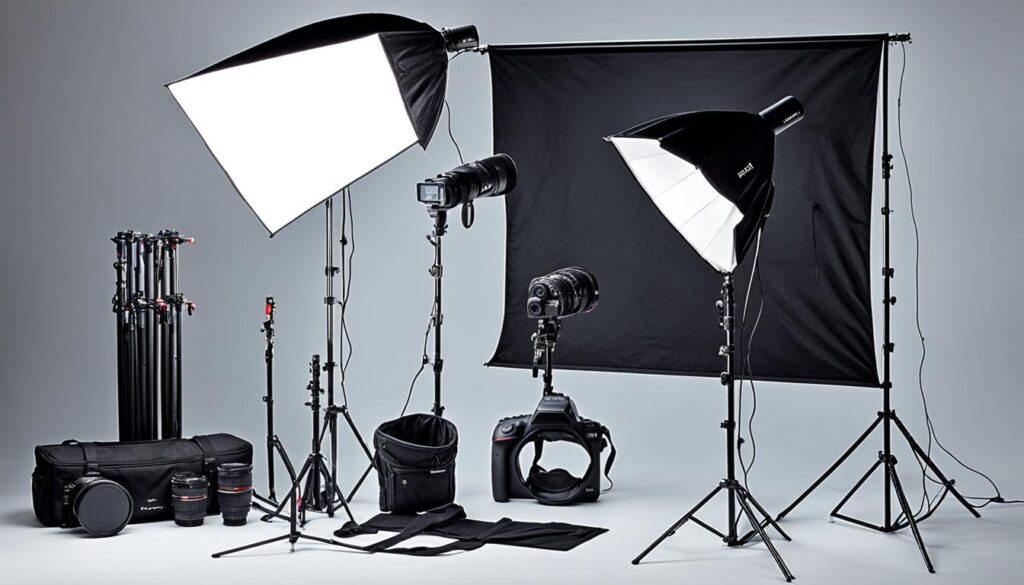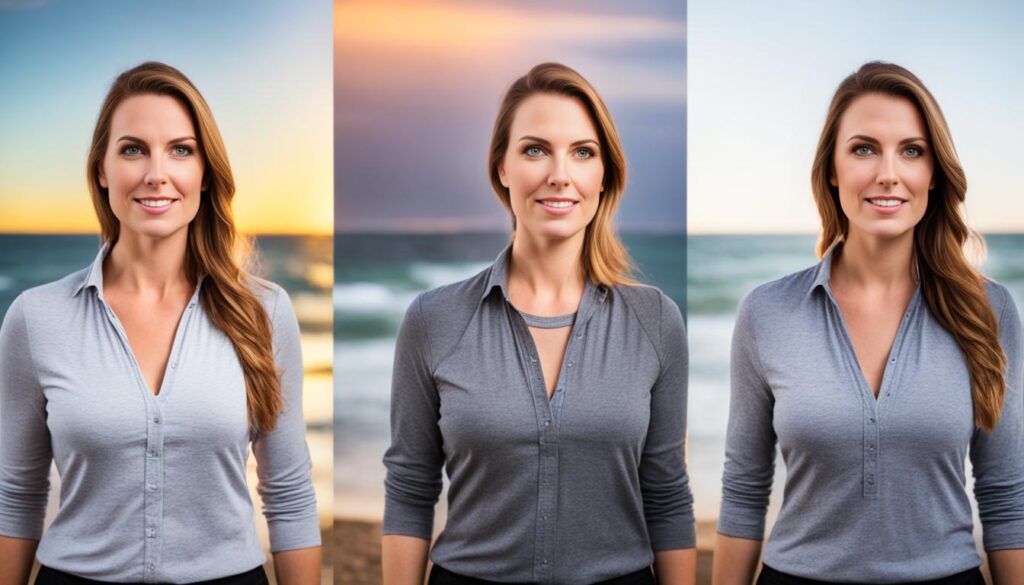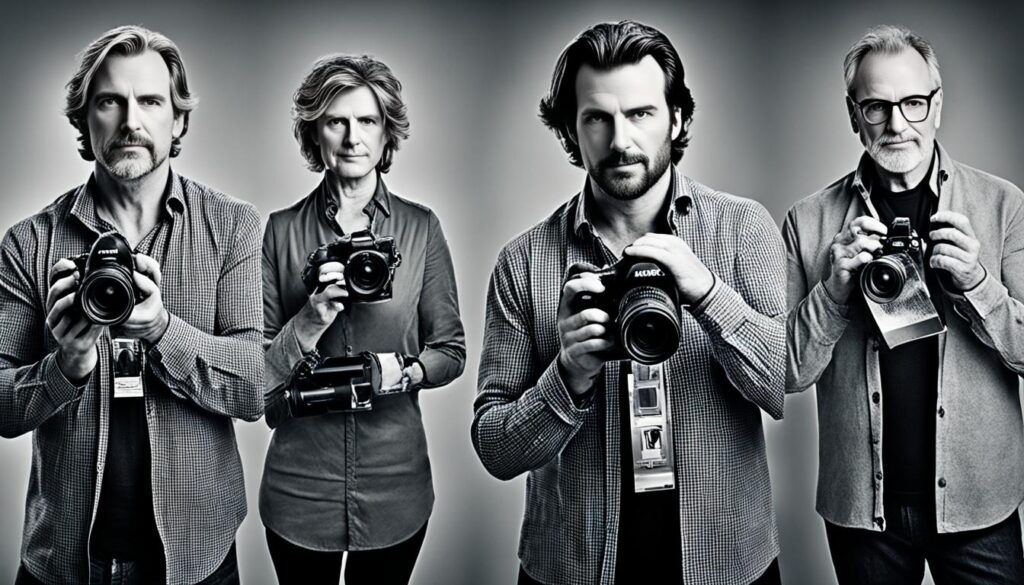How to Become a Portrait Photographer
Becoming a portrait photographer can be an exciting and fulfilling career choice. In this article, I will explore the steps to becoming a portrait photographer, from mastering the necessary technical skills to building a successful business and creating a striking portfolio. Whether you are a beginner looking to get started or an aspiring professional seeking to take your career to the next level, this guide will provide valuable insights and tips.
Key Takeaways
- Developing technical skills and artistic expression are crucial for becoming a professional portrait photographer.
- Portrait photography encompasses various styles, from traditional portraits to fine art and candid photography.
- Choosing the right equipment, including cameras, lenses, lighting, tripods, and backdrops, is essential for capturing high-quality portraits.
- Creating a unique style and building a strong portfolio is important for standing out in the competitive photography industry.
- Marketing yourself effectively, networking, and utilizing social media are key strategies for growing your portrait photography business.
The Fascinating World of Portrait Photography
Portrait photography is a diverse and captivating genre that involves capturing the essence of an individual or a group. This art form allows photographers to express their creativity while telling unique stories through images. From traditional posed portraits to creative and abstract fine art portraits, several types of portrait photography exist, each offering challenges and opportunities for artistic expression.
Traditional portrait photography focuses on capturing individuals in a posed and formal manner. It often involves carefully selecting the composition, lighting, and background to create a classic and timeless image. These portraits are often used for professional headshots, family portraits, or formal occasions.
Traditional portraits allow the subjects to showcase their best selves in a confident and dignified way.
Fine art portrait photography, on the other hand, pushes the boundaries of creativity and experimentation. It aims to create visually striking and thought-provoking images that challenge traditional notions of portraiture. Fine art portraits often utilize unconventional techniques, unique posing, and imaginative compositions to convey a specific mood or concept.

Candid photography, or documentary or photojournalistic style, captures people in natural and unposed moments. The goal is to capture authentic emotions and genuine interactions, offering a glimpse into the subject’s personality and life. Candid portraits are often used in storytelling and photojournalism, capturing the raw and spontaneous moments that convey a narrative.
Portrait photography is vast and ever-evolving, with various styles and approaches to explore. Whether you prefer the traditional elegance of posed portraits, the artistic expression of fine art photography, or the authenticity of candid moments, there is no limit to the possibilities that portrait photography offers. In the next sections of this article, we will delve into the technical aspects and skills needed to excel in this fascinating genre.
Essential Equipment to Get Started as a Portrait Photographer
The right equipment is crucial to capturing high-quality and visually appealing portraits as a portrait photographer. This section will explore the essential equipment needed to kickstart your journey in portrait photography.
Camera Essentials: Choosing the Right Tool for Portrait Photography
When it comes to portrait photography, selecting the right camera is a fundamental decision. Consider factors such as image quality, resolution, sensor size, and autofocus capabilities. Popular camera choices for portrait photographers include the Nikon D850 and the Canon EOS 5D Mark IV. Remember to choose a camera that suits your budget and meets your needs.
Lenses and Their Roles in Creating Stunning Portraits
Lenses play a significant role in capturing captivating portraits. Prime lenses with a wide aperture, such as the Canon EF 85mm f/1.2L II USM or the Nikon AF-S 85mm f/1.4G, are preferred to create a shallow depth of field and produce stunning bokeh. Additionally, a versatile portrait lens like the Sony FE 24-70mm f/2.8 GM can be a valuable addition to your arsenal, allowing you to capture a variety of compositions and perspectives.
Lighting: The Heart of Portrait Photography
Understanding lighting techniques is crucial for achieving the desired results in portrait photography. Investing in a reliable and adjustable lighting system, such as the Profoto B10 Plus or the Godox AD200 Pro, can significantly enhance your ability to control and manipulate light. Light modifiers like softboxes, reflectors, and diffusers can also help create flattering and well-balanced lighting setups for your subjects.
Understanding the Importance of Tripods and Backdrops
While often overlooked, tripods and backdrops are essential tools for portrait photographers. A sturdy tripod, such as the Manfrotto 055XPRO3, provides stability and helps eliminate camera shake, resulting in sharper images. Backdrops, like the Savage Widetone Seamless Background Paper, allow you to create a professional and consistent look for your portraits, whether in a studio or on location.
Investing in the right portrait photography equipment, including a well-suited camera, lenses, lighting, tripods, and backdrops, gives you the necessary tools to bring your creative vision to life. With practice and experimentation, you can master the art of portrait photography and capture stunning portraits that resonate with viewers.

Discovering Your Unique Style in Portrait Photography
Developing a unique style is important to becoming a successful portrait photographer. You can express your artistic vision through your style and create photographs that resonate with you and your audience. While technical skills are crucial, your style sets you apart from other photographers and defines your artistic expression.
To develop your unique style, it’s essential to experiment with different techniques and approaches. Don’t be afraid to step outside the traditional boundaries of portrait photography and explore new creative avenues. Embrace your artistic instincts and allow yourself to take risks.
One way to uncover your style is by studying the work of other portrait photographers who have already established their unique styles. Take inspiration from their compositions, lighting techniques, and use of colours. However, remember that imitation is not the goal. Rather, use these inspirations as a springboard to forge your path and develop a style that reflects your artistic voice.
Experimentation is key. Try shooting portraits using different camera angles, playing with lighting and shadows, and exploring post-processing techniques that enhance your images. You may discover an authentic style by pushing yourself out of your comfort zone and trying new things.
Building a distinctive style is essential for personal and creative fulfilment and attracting clients who resonate with your artistic expression. Your unique style becomes your trademark, the visual identity that distinguishes you from other photographers in the industry.
By developing a strong and consistent style, you can attract clients specifically looking for that style. Your unique approach will attract clients, make you more memorable, and help you stand out in a crowded market.
To summarize, developing a unique style in portrait photography is a journey of self-discovery and experimentation. Embrace your creative instincts, study the work of other photographers for inspiration, and never be afraid to take risks. Your style sets you apart and allows you to express your artistic vision and create impactful portraits.
Mastering Technical Skills for Professional Portrait Photography
Mastering the technical skills required for portrait photography is crucial for creating professional and visually stunning portraits. This section will delve into the key technical skills you need to learn to elevate your portrait photography to the next level.
The Exposure Triangle: A Vital Component for Perfect Portraits
Understanding the exposure triangle is essential for achieving perfectly exposed portraits. The exposure triangle consists of three elements: aperture, shutter speed, and ISO. By controlling these three factors, you can adjust the amount of light that enters the camera and capture well-balanced images.

To effectively utilize the exposure triangle, consider the following:
- Aperture: The aperture determines the depth of field in your portrait. A wider aperture (smaller f-number) creates a shallow depth of field, resulting in a blurred background and a focus on the subject. Experimenting with different aperture settings allows you to showcase the details or isolate specific features of your subject.
- Shutter Speed: Shutter speed controls the duration of the exposure. A faster shutter speed freezes motion, making it ideal for capturing sharp portraits with minimal blur. On the other hand, a slower shutter speed can create a sense of movement or motion blur, adding an artistic touch to your portraits.
- ISO: ISO determines the camera’s sensitivity to light. Adjusting the ISO allows you to shoot in different lighting conditions. A lower ISO is suitable for well-lit environments, while a higher ISO is necessary for low-light situations. However, higher ISO settings may introduce noise or grain into your images, so find the optimal balance for your desired outcome.
Post-Processing Skills: From Raw Image to Artistic Expression
Post-processing plays a crucial role in bringing your portraits to life. It allows you to enhance the details, adjust the colours, and add your artistic style to the images. Here are some important post-processing skills to develop:
- RAW Image Processing: Shooting in RAW format gives you more control over the editing process. Learning to process RAW images using software like Adobe Lightroom or Capture One lets you fine-tune your portraits’ exposure, white balance, and overall tone.
- Colour Correction and Enhancement: Adjusting the colours in your portraits can significantly impact the mood and atmosphere of the image. Develop your colour correction and enhancement skills to create visually appealing portraits that accurately represent the subject.
- Retouching: Portraits often benefit from minor retouching to enhance the subject’s appearance. Master retouching techniques to subtly remove blemishes, smoothen skin, and bring out the natural beauty of your subjects while preserving their unique features.
Lighting Techniques: Crafting the Mood with Shadows and Highlights
Lighting is a fundamental element in portrait photography that can dramatically influence the mood and impact of your images. By mastering various lighting techniques, you can shape the atmosphere and highlight specific features of your subject.
Experiment with the following lighting techniques to enhance your portraits:
- Natural Light: Utilize natural light sources such as sunlight or window light to create soft, flattering lighting conditions. Position your subject in relation to the light source to achieve desired results.
- Studio Lighting: Learn how to use artificial lighting equipment, including strobes, softboxes, and reflectors, to create controlled lighting setups. Mastering studio lighting techniques allows for greater consistency and flexibility in capturing portraits.
- Low-Key and High-Key Lighting: Explore low-key lighting for dramatic, moody portraits with deep shadows. Alternatively, high-key lighting creates bright, evenly lit portraits with minimal shadows, evoking a sense of openness and clarity.

By mastering technical skills such as the exposure triangle, post-processing, and lighting techniques, you can elevate your portrait photography to new heights. Combined with your artistic vision, these skills will allow you to create professional and visually stunning portraits that leave a lasting impression.
How to Become a Portrait Photographer: Building a Business
Building a successful portrait photography business takes more than just technical skills. You must develop essential business skills and strategies to establish yourself as a professional portrait photographer. This section will explore the steps and considerations involved in starting and running a portrait photography business.

Starting a portrait photography business begins with creating a solid business plan. It will serve as your roadmap, outlining your goals, target market, pricing, and marketing strategies. A well-crafted business plan will provide a clear direction and help you make informed decisions.
A successful portrait photographer not only understands the technical aspects of photography but also possesses strong business acumen. – Emma Johnson
One of the key aspects of running a portrait photography business is setting competitive pricing. You need to determine your worth and the value of your services while remaining competitive. Consider your expertise, experience, equipment costs, overhead expenses, and desired profit margin.
Marketing your services is crucial for attracting and building a strong client base. Utilize various marketing channels, both online and offline, to reach your target audience. This may include creating a professional website, leveraging social media platforms, participating in local events, and networking with other professionals in the industry.
Building a strong brand identity is also essential in the fiercely competitive world of portrait photography. Develop a unique selling proposition that sets you apart from your competitors. Highlight your style, approach, and the unique benefits you offer to clients. Consistency in branding and messaging will reinforce your professional image and attract the right clientele.
Gaining business skills for portrait photographers is an ongoing process. Continuously seek opportunities for professional development and stay updated with the latest trends and techniques in the industry. Attend workshops, conferences, and online courses to expand your knowledge and stay ahead of the curve.
| Business Skills for Portrait Photographers | Key Considerations |
|---|---|
| Business Planning | Create a comprehensive business plan with clear goals and strategies. |
| Pricing Strategy | Determine competitive pricing based on your value and market research. |
| Marketing and Promotion | Utilize various marketing channels to reach and attract your target clients. |
| Brand Identity | Develop a unique brand identity that differentiates you from competitors. |
| Continuous Learning | Stay updated with the latest industry trends and techniques through professional development. |
You can establish and grow a thriving portrait photography business by combining your technical skills with strong business acumen. Remember, the ability to create stunning portraits is just one part of the equation. Equipping yourself with the necessary business skills will advance your career.
Creating a Striking Portrait Photography Portfolio
Your portfolio is crucial for showcasing your skills and attracting potential clients. I will guide you through creating a striking portrait photography portfolio in this section. We will explore how you can draw inspiration from renowned portrait photographers, curate your best work, and effectively showcase your portfolio online to reach a wider audience and increase your visibility in the industry.
Inspiration from Renowned Portrait Photographers
When creating your portrait photography portfolio, seeking inspiration from renowned portrait photographers is beneficial. By studying their work, you can gain insights into composition, lighting techniques, posing, and overall artistic expression. Take note of the photographers whose style resonates with you and analyze the elements that make their portraits impactful. Remember, while drawing inspiration is important, developing your unique style and voice is equally essential.

Choosing Your Best Work: The Art of Curating a Portfolio
Curating a portfolio is like curating an art exhibition. It requires carefully selecting and presenting your best work to tell a compelling visual story. Start by reviewing all your images and identifying the ones that demonstrate your technical skills, creativity, and ability to capture the essence of your subjects. Consider factors such as composition, lighting, emotional impact, and consistency of vision. Aim for a diverse but cohesive collection that showcases your versatility and expertise.
| Criteria | Explanation |
|---|---|
| Technical Skills | Showcase unique and innovative portraits highlighting your artistic vision and ability to think outside the box. |
| Creativity | Select compelling visuals that spark strong feelings, encapsulating the essence of your subjects’ characters, sentiments, or narratives. |
| Emotional Impact | Choose images that evoke an emotional response, capturing your subjects’ personalities, emotions, or stories. |
| Consistency | Ensure your portfolio has a consistent style and cohesive visual narrative, creating a sense of harmony among the images. |
Online Presence: Showcasing Your Portfolio Digitally
In today’s digital world, you must showcase your portfolio online to reach a wider audience and potential clients. Create a professional website or use dedicated platforms for photographers to showcase your work. Your online portfolio should have a clean and user-friendly design, allowing visitors to navigate easily and focus on the images. Pay attention to the organization of your portfolio, categorizing it into different sections if necessary. Implement SEO strategies, such as using relevant keywords, to optimize your portfolio for search engines and improve your online visibility.
Remember to regularly update your portfolio with new work and remove images that no longer align with your style or quality standards. Regularly share your portfolio on social media platforms and engage with your audience by providing behind-the-scenes insights, sharing photography tips, or telling the stories behind your images. Building an active online presence will help you establish your brand and attract potential clients.
Marketing Yourself as a Professional Portrait Photographer
Marketing is vital in establishing a successful career as a portrait photographer. It involves building industry connections, utilizing social media platforms for increased visibility, and implementing effective pricing strategies that accurately reflect the value of your work. In this section, I will guide you through these essential aspects of marketing yourself as a professional portrait photographer.
Networking and Collaboration: Building Industry Connections
Networking and collaboration are powerful tools for building industry connections and expanding your reach as a portrait photographer. By actively participating in photography events, workshops, and online communities, you can connect with like-minded professionals, gain insights from experienced photographers, and even collaborate on projects. Networking opens doors to new opportunities and helps you establish a strong reputation within the industry.
To effectively network and build industry connections:
- Attend photography conferences, workshops, and exhibitions to meet fellow photographers, industry experts, and potential clients.
- Join online photography communities, forums, and social media groups to engage with other photographers, share your work, and learn from their experiences.
- Collaborate with models, makeup artists, stylists, and other professionals in the industry to create stunning and diverse portfolios.
Utilising Social Media for Increased Visibility
Social media platforms offer immense opportunities for showcasing your work, attracting clients, and establishing a strong online presence as a portrait photographer. Creating engaging and visually appealing content on platforms like Instagram, Facebook, and LinkedIn can help you reach a wider audience and build a loyal following. Here are some strategies for effectively utilizing social media:
- Consistently post high-quality images that represent your unique style and expertise.
- Use relevant hashtags to increase the discoverability of your posts and attract potential clients searching for specific types of portrait photography.
- Engage with your audience by responding to comments, messages, and inquiries promptly and professionally.
- Collaborate with influencers or brand ambassadors to expand your reach and gain exposure to their audiences.
Remember, social media is a platform for sharing your work and an opportunity to establish your brand and connect with your target audience.
Pricing Strategies: Valuing Your Work Appropriately
Setting the right prices for your portrait photography services is crucial for attracting clients and ensuring your work is properly valued. Determining your pricing strategy involves considering factors such as your skill level, experience, market demand, and overhead costs. Here are some tips to help you develop an effective pricing strategy:
- Research the market rates for portrait photography services in your area to gain insights into industry standards and competitor pricing.
- Consider the time, effort, and expenses involved in the process, including pre-production, shooting, post-processing, and client communication.
- Factor in the quality and uniqueness of your work, your level of expertise, and the value you provide to clients.
- Offer different packages or tiers of services to cater to various budgets and client preferences.
- Regularly evaluate and adjust your prices based on changes in your skill level, experience, and market demand.
By valuing your work appropriately, you ensure fair compensation for your expertise and attract clients who value and appreciate the quality of your portraits.
You can effectively market yourself as a professional portrait photographer with effective networking, a strong social media presence, and a well-considered pricing strategy. These marketing techniques will help you establish a solid reputation, attract clients, and pave the way for a successful career in portrait photography.

Expanding Your Skills with Continuous Learning and Practice
Continuous learning and practice are pivotal for skill improvement and growth as a portrait photographer. By embracing a lifelong learning mindset, you can enhance your technical skills, foster creativity, and drive innovation.
There are various avenues to expand your skills and knowledge in portrait photography:
- Photography Workshops: Attend workshops conducted by industry experts to gain valuable insights and learn new techniques. Workshops provide hands-on experience, allowing you to refine your skills and connect with fellow photographers in a collaborative environment.
- Online Courses: Enroll in online courses tailored to the needs of portrait photographers. These courses offer flexibility in learning at your own pace and cover various topics, from composition and lighting to post-processing and business strategies.
- Experimentation: Dedicate time to experimenting with new techniques and approaches in your photography. This allows you to push your creative boundaries, discover your style, and develop a unique artistic voice.
- Staying Updated: Keep abreast of the latest trends and advancements in the industry through photography blogs, magazines, and online resources. This ensures your work remains relevant and reflects your client’s evolving needs and preferences.
Continuous learning and practice enhance your technical skills and give you the confidence and versatility to tackle diverse photography assignments. Remember, the journey of a portrait photographer is a continuous pursuit of improvement and exploration.
Conclusion
In conclusion, the journey to becoming a portrait photographer in the UK is a multi-faceted one that requires a combination of technical skills, artistic expression, business acumen, and continuous learning. By following the steps and strategies outlined in this guide, you will be well-equipped to embark on a successful career in portrait photography.
Remember, staying true to your unique style is essential. As you progress in your career, continuously growing and adapting to new trends and techniques will set you apart. Never stop pursuing your passion for capturing the essence of individuals through the art of portraiture.
Whether you are a beginner looking to get started or an aspiring professional seeking to take your career to the next level, this guide has provided valuable insights and tips. With dedication, practice, and a commitment to learning, you can turn your passion for portrait photography into a fulfilling and rewarding profession.
FAQ’S
Q: What is portrait photography and its significance in photography?
A: Portrait photography involves taking photographs of individuals or groups in a way that captures their personality and character. It is a popular form of photography that focuses on the subject’s face or body.
Q: How can I start a portrait photography business?
A: To start a portrait photography business, you must develop your photography skills, invest in quality equipment, build a portfolio, market your services, and establish a pricing structure.
Q: What are the different types of portrait photography?
A: The different types of portrait photography include traditional portraits, environmental portraits, candid portraits, and creative portraits. Each type has its style and approach.
Q: How important are soft skills for a successful portrait photographer?
A: Soft skills, such as interpersonal skills, communication, and empathy, are crucial for a successful portrait photographer. These skills help establish a connection with clients and create a comfortable environment during photo sessions.
Q: Is a degree in photography necessary to become a successful professional photographer?
A: While a degree in photography can provide valuable knowledge and skills, it is not always necessary to become a successful professional photographer. Many photographers have built successful careers through self-learning and hands-on experience.
Q: What is candid photography in the context of portrait photography?
A: Candid photography in portrait photography involves capturing spontaneous and natural moments of individuals without their knowledge or posing. It aims to capture authentic emotions and expressions.
Q: How can I make a career in portrait photography if I have no formal training?
A: If you do not have formal photography training, you can still make a career in portrait photography by learning through online resources, workshops, mentorship programs, and practice. Developing your photography skills and building a strong portfolio is essential.








